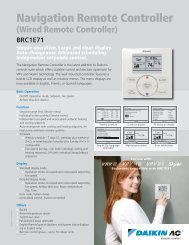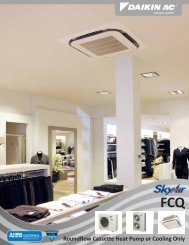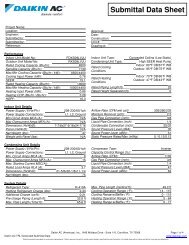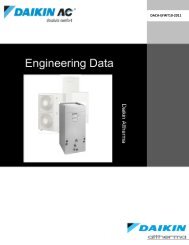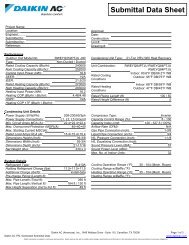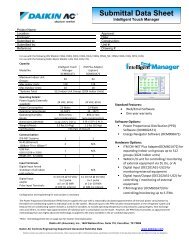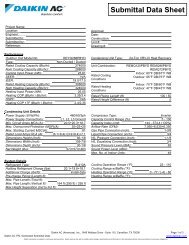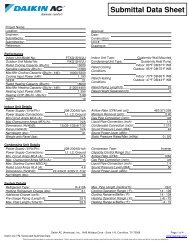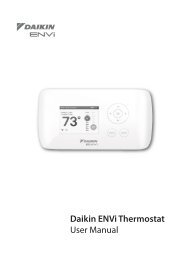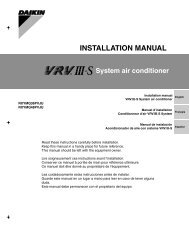VRV III General Information - Daikin AC
VRV III General Information - Daikin AC
VRV III General Information - Daikin AC
You also want an ePaper? Increase the reach of your titles
YUMPU automatically turns print PDFs into web optimized ePapers that Google loves.
CAUTION FOR REFRIGERANT LEAKS EDUS391004-M<br />
9. CAUTION FOR REFRIGERANT LEAKS<br />
(Points to note in connection with refrigerant leaks)<br />
Introduction:<br />
The installer and system specialist shall secure safety<br />
against leakage according to local regulations or<br />
standards. The following standards may be applicable if<br />
local regulations are not available.<br />
The <strong>VRV</strong> System, like other air conditioning systems, uses R-<br />
410A as refrigerant. R-410A is an entirely safe non-toxic, noncombustible<br />
refrigerant. Nevertheless care must be taken to<br />
ensure that air conditioning facilities are installed in a room<br />
that is sufficiently large. This assures that the maximum<br />
concentration level of refrigerant gas is not exceeded, in the<br />
unlikely event of major leak in the system and this in<br />
accordance to the local applicable regulations and standards.<br />
Maximum concentration level<br />
The maximum charge of refrigerant and the calculation of the<br />
maximum concentration of refrigerant is directly related to the<br />
humanly occupied space in to which it could leak.<br />
The unit of measurement of the concentration is lb/ft 3 (the<br />
weight in lb of the refrigerant gas in 1 ft3 volume of the<br />
occupied space).<br />
Compliance to the local applicable regulations and standards<br />
for the maximum allowable concentration level is required.<br />
1. direction of the refrigerant flow<br />
2. room where refrigerant leak has occurred (outflow of all<br />
the refrigerant from the system)<br />
Pay special attention to the place, such as a basement,<br />
etc., where refrigerant can stay, since refrigerant is<br />
heavier than air.<br />
Procedure for checking maximum concentration<br />
Check the maximum concentration level in accordance with<br />
steps 1−2 below and take whatever action is necessary to<br />
comply.<br />
1. Calculate the amount of refrigerant (lb) charged to each<br />
system separately.<br />
amount of refrigerant<br />
in a single unit<br />
system (amount of<br />
refrigerant with<br />
which the system is<br />
charged before<br />
leaving the factory)<br />
+<br />
additional charging<br />
amount (amount of<br />
refrigerant added<br />
locally in accordance<br />
with the length or<br />
diameter of the refrigerant<br />
piping)<br />
Where a single refrigerant facility is divided into 2 entirely<br />
independent refrigerant systems then use the amount of<br />
refrigerant with which each separate system is charged.<br />
2. Follow local code requirements (ASHRAE-15 2007 &<br />
ASHRAE-34 2007).<br />
=<br />
total amount<br />
of refrigerant<br />
(lb) in the<br />
system<br />
46 <strong>General</strong> <strong>Information</strong>




